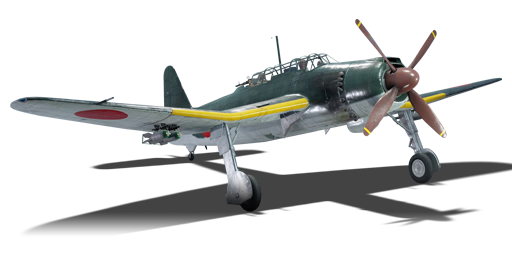



The B7A2 was a carrier-borne torpedo-dive bomber developed by Aichi for the Imperial Japanese Navy Air Service during the Second World War. It was designed to replace the B6N Tenzan and the D4Y Suisei in the Navy's service. It had a mid-wing configuration with an inverted gull wing, a four-bladed propeller, and a bomb bay. It was powered by the Nakajima NK9C Homare 12 radial engine, which was expected to become the Navy's standard engine in its power range. The plane was intended to operate from the new Taihō-class carriers, which had larger deck elevators than the older carriers. The plane first flew in May 1942, but production was delayed by various problems with the engine and the airframe. Only 114 planes were built before the war ended. The plane saw limited action in the final stages of the war, mainly from land bases, and did not have much opportunity to demonstrate its potential.
The Ryusei was introduced in Update 1.37. While it looks like a rather large simple torpedo bomber, it is deceivingly manoeuvrable and fast for its vehicle class; this, however, is exchanged for a lack of armour. On top of that, it can bite back with its defensive 13 mm machine gun or engage frontally with two wing-mounted Type 99 Model 2 cannons. While technically classified as a carrier-borne torpedo bomber, it is very capable of fulfilling the roles of dive-, level-, and torpedo bombing targets. While the max tonnage of bombs doesn't increase over the previous B6N Tenzan, it can carry four additional wing-mounted 60 kg bombs next to its bomb bay that can load two 250 kg or six 60 kg bombs. The main playstyle of the B7A2 is more like an unarmoured attacker, using its arsenal of bombs and cannons on targets either in the sky, on the ground, or on the sea with the deadly precision of its gyrostabilized dive-bomber sight.
flaps
flaps
flaps
brake
| Belt | Belt filling | Armor penetration (mm) at a distance: | |||||
|---|---|---|---|---|---|---|---|
| 10 m | 100 m | 500 m | 1000 m | 1500 m | 2000 m | ||
| T/FI/FI/APHE | 26 | 24 | 17 | 10 | 6 | 4 | |
| HEF-T/HEF/HEF/APHE | 26 | 24 | 17 | 10 | 6 | 4 | |
| APHE/APHE/APHE/APHE/HEF/HEF-T | 26 | 24 | 17 | 10 | 6 | 4 | |
| HEF-T | 4 | 4 | 4 | 4 | 4 | 4 | |
| HEF/HEF/HEF/APHE/APHE | 26 | 24 | 17 | 10 | 6 | 4 | |
| Belt | Belt filling | Armor penetration (mm) at a distance: | |||||
|---|---|---|---|---|---|---|---|
| 10 m | 100 m | 500 m | 1000 m | 1500 m | 2000 m | ||
| I/AP-T/HEF-T/T/HEF-I | 18 | 16 | 9 | 5 | 3 | 1 | |
| T/AP-T/AP-T/AP-T/I | 18 | 16 | 9 | 5 | 3 | 1 | |
| AP-T/HEF-T/HEF-I/HEF-T/T | 18 | 16 | 9 | 5 | 3 | 1 | |
4 × 60 kg Navy Type 97 Number 6 ground bomb












Flight performance | |
|---|---|
Survivability |
|---|
Weaponry | |
|---|---|